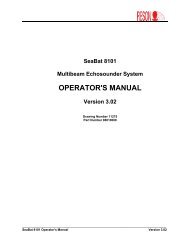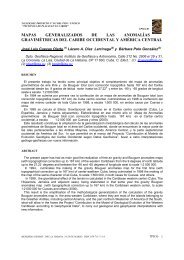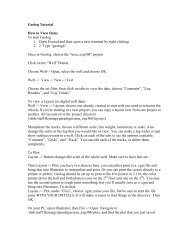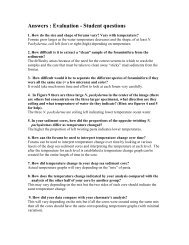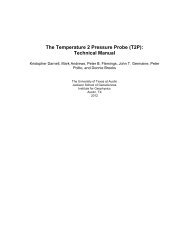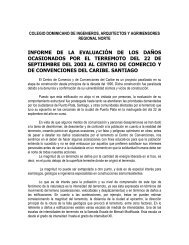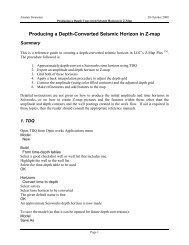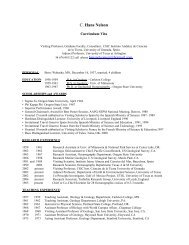INDEX I. THE P-3C VIBROCORER - GENERAL DESCRIPTION ...
INDEX I. THE P-3C VIBROCORER - GENERAL DESCRIPTION ...
INDEX I. THE P-3C VIBROCORER - GENERAL DESCRIPTION ...
You also want an ePaper? Increase the reach of your titles
YUMPU automatically turns print PDFs into web optimized ePapers that Google loves.
P-<strong>3C</strong> MANUAL (Rev.10/99)<br />
is then fitted over the threaded rods. Insert the two 1/4-20 bolts on the side of the clamp's<br />
body and tighten. This locks the threaded rod's rotation. Next, using the extended socket<br />
tool provided, install the two "thin" 1/2-13 stainless steel nuts onto the rods and tighten. The<br />
"Stationary" portion of the clamp never needs to be removed unless access to the ball valve<br />
is necessary.<br />
2. Install the "Movable jaws. Put a flat washer over each threaded rod, place the first<br />
movable jaw over the rods and add another flat washer between the two jaws. Add the last<br />
flat washer and a Nylock nut onto the rods and draw the nuts up, but do not tighten them yet.<br />
3. Insert the four horizontal bolts through the two sets of jaws connecting them to each<br />
other. Snug the four nuts on the bolts to secure the stationary jaws to the movable jaws.<br />
NOTE: The clamp uses a combination of stainless steel bolts and plated steel nuts. When<br />
ever possible, DO NOT USE stainless bolt and stainless nuts together. With repeated use,<br />
there is a possibility that the stainless nut will seize on the stainless bolt.<br />
4. Insert a coretube into the clamp and into until the coretube stops at the 4"ID inside<br />
shoulder of the stationary jaw.<br />
5. When tightening the clamp around a coretube, first sung up all the "plated" steel nylock<br />
nuts six total (6). For final tightening, first do the four horizontal bolt drawing the jaws<br />
together and then the two vertical nuts on the threaded rods. Do not over tighten! Apply 60<br />
to 90 ft.lb./in. Use a 1/2” drive ratchet only. Do not use an extension bar or breaker bar.<br />
NOTE: 1. If any of the nuts & bolts associated with the coretube clamp are loosened<br />
during vibration, problems may arise: (1) The coretube may be damaged and break below<br />
the clamp, staying in the ground. (2) The amperage draw may raise and exceed the limits of<br />
the power source preventing the operation of the Vibrohead. Always use a softer steel nut<br />
on a stainless bolt.<br />
CONNECTING <strong>THE</strong> UNDERWATER POWER CABLE<br />
The Underwater Power Cable's (UPC) length, style, and manufacture is the decision of each<br />
individual customer. However, one aspect that is common with any UPC is the ability to<br />
mate the connector properly to form a watertight seal. If water should enter the mated<br />
connectors, even a single drop, damage will result causing the replacement of the<br />
connector(s) and even a section of the UPC.<br />
The P-<strong>3C</strong> Vibrohead Terminal Connector Assembly mounted on the pressure housing<br />
includes a Penetrator, a cable lead and a CCP Connector. The penetrator, supplied by<br />
Impulse Enterprise, San Diego, is a stainless steel penetrator style "bulkhead connector"<br />
MSSG-4-BCR-PNA specially modified from the MSSG series to provide the additional<br />
bore-seal O-Ring. Internally, this single penetrator is connected to both vibrator motors<br />
inside the vibrohead. Externally it is molded to a Kevlar reinforced, 12 gauge, 4 conductor<br />
neoprene cable which in turn is molded to a Impulse Epoxy XSL-4-CCP connector.<br />
- 10 -



